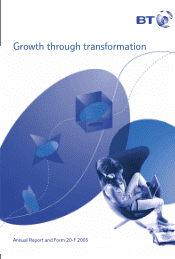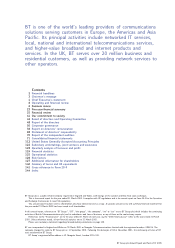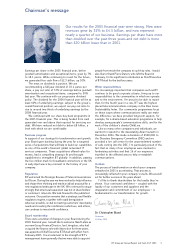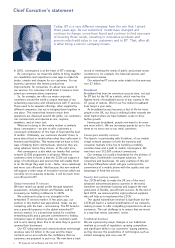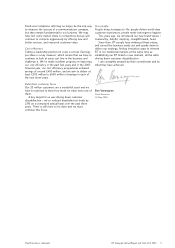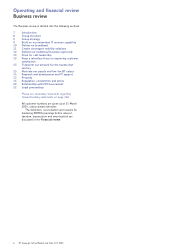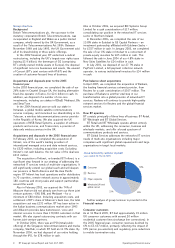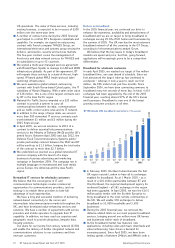BT 2005 Annual Report Download - page 9
Download and view the complete annual report
Please find page 9 of the 2005 BT annual report below. You can navigate through the pages in the report by either clicking on the pages listed below, or by using the keyword search tool below to find specific information within the annual report.
Group structure
Background
British Telecommunications plc, the successor to the
statutory corporation British Telecommunications, was
incorporated in England and Wales as a public limited
company, wholly owned by the UK Government, as a
result of the Telecommunications Act 1984. Between
November 1984 and July 1993, the UK Government sold
all of its shareholding in three public offerings.
In the 2002 financial year, BT undertook a radical
restructuring, including the UK’s largest-ever rights issue
(raising £5.9 billion), the demerger of O2 (comprising
BT’s wholly-owned mobile assets in Europe), the disposal
of significant non-core businesses and assets, the unwind
of Concert (BT’s joint venture with AT&T) and the
creation of customer-focused lines of business.
Acquisitions and disposals prior to the 2005
financial year
In the 2003 financial year, we completed the sale of our
26% stake in Cegetel Groupe SA, the leading alternative
fixed-line operator in France, for £2.6 billion in cash. In
addition, we disposed of a number of non-core
investments, including our stakes in BSkyB, Mediaset, Blu
and SmarTone.
In the 2004 financial year we sold our stake in
Inmarsat, a global mobile satellite communications
services company, and monetised our shareholding in LG
Telecom, a wireless telecommunications service provider
in the Republic of Korea. We also acquired the UK
operations of NSB Retail Systems, a supplier of software
products and services, and Transcomm, a provider of
data-only wireless services in the UK.
Acquisitions and disposals in the 2005 financial year
In February 2005, we completed the acquisition of
Infonet, one of the world’s leading providers of
international managed voice and data network services,
for £520 million, including acquisition costs. Excluding
Infonet’s net cash balance, the net value of the deal was
£315 million.
The acquisition of Infonet, re-branded BT Infonet, is a
significant step forward in our strategy of addressing the
networked IT services needs of multi-site organisations. It
will significantly extend our global reach and will deepen
our presence in North America and the Asia Pacific
region. BT Infonet has local operations and/or distributors
in 70 countries, remote network access in approximately
180 countries and strong sales and support partnerships
around the world.
Also in February 2005, we acquired the 74% of
Albacom that we did not already own from our three joint
venture partners – ENI, BNL and Mediaset – for a
minimum of £80 million. Including acquisition costs, and
settlement of BT’s share of Albacom’s bank loan, the total
acquisition cost was £131 million. BT has been active in
the Italian business communications market since 1995
and Albacom provides data transmission, voice and
internet services to more than 170,000 customers in that
market. We also signed outsourcing contracts with our
former joint venture partners.
In October 2004, there was an IPO (initial public
offering) of the Singapore telecommunications and media
company, StarHub, in which BT held an 11.9% stake. By
November 2004, we had disposed of our entire holding,
through the IPO, for £78 million in cash.
Also in October 2004, we acquired BIC Systems Group
Limited for a cash consideration of £17 million,
consolidating our position in the networked IT services
sector in Northern Ireland.
In December 2004, we completed the sale of our
15.8% stake in Eutelsat to GS Capital Partners – an
investment partnership affiliated with Goldman Sachs –
for £357 million in cash. In January 2005, we completed
the sale of our 4% stake in Intelsat to a consortium of
private equity investors for £65 million in cash. This
followed the sale in June 2004 of our 4.8% stake in
New Skies Satellites for £24 million in cash.
In July 2004, we disposed of our 27.7% stake in
PayPoint Limited, a bill payment collection network
operator, to various institutional investors for £34 million
in cash.
Post balance sheet acquisitions
In April 2005, we completed the acquisition of Radianz,
the leading financial services extranet provider, from
Reuters for a cash consideration of £107 million. The
purchase of Radianz is another vital step in our
transformation into a global provider of networked IT
services. Radianz will continue to provide high-quality
extranet services for Reuters and the global financial
services market.
How BT operates
BT consists principally of three lines of business: BT Retail,
BT Wholesale and BT Global Services.
BT Retail and BT Wholesale operate almost entirely
within the UK, addressing the consumer, business and
wholesale markets, and offer a broad spectrum of
communications products and services.
BT Global Services addresses the networked IT services
needs of multi-site organisations including major
companies with significant global requirements and large
organisations in target local markets.
Group turnover by customer segment
y
ear ended 31 March 2005
Wholesale (UK and
global carrier)
Major corporate
24%
30%
13%
33%
Consumer
Business
Further analysis of group turnover is provided in the
Financial review.
Consumer customers
As at 31 March 2005, BT had approximately 19 million
UK consumer customers with around 20 million
residential customer lines (exchange line connections). In
the 2005 financial year, consumer revenues declined by
6% to £5,637 million, primarily reflecting the impact of
CPS (carrier pre-selection) and regulatory price reductions
to mobile termination rates.
8BTGroup plc Annual Report and Form 20-F 2005 Operating and financial review

